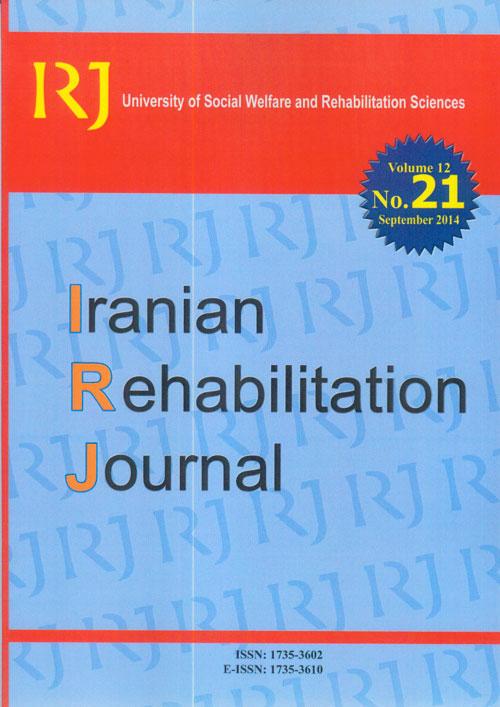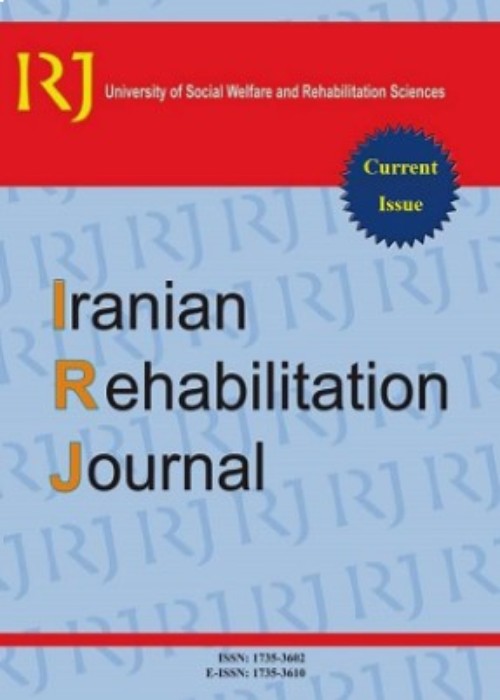فهرست مطالب

Iranian Rehabilitation Journal
Volume:12 Issue: 21, Sep 2014
- تاریخ انتشار: 1393/09/06
- تعداد عناوین: 9
-
-
Pages 4-5Mental rehabilitation can include a range of disabling conditions, from severe and enduring psychotic or bipolar disorders to more transient affective disorders. The concept of rehabilitation reflects the concept of disability. If the concept of mental illness is viewed as a mechanism for social control, then we can say that one of the most powerful aspects of the medicalization of the individual is the application by physicians of diagnostic labels. It attempts to approach the issue of psychological rehabilitation (1-3) from a bio-psychosocial viewpoint, recognizing that a person’s physical, mental, motional, social and spiritual needs should be considered in the rehabilitation process. This multidisciplinary view focuses on recovery-oriented care of persons with mental health problems and on their rehabilitation program. An individual’s experience of a particular impairment needs to be understood within its social context and processes of socialization (4). Again here the role of psycho-rehabilitation programs will be magnetized in the mental health care (5).Keywords: Psychosocial Rehabilitation, Mental Health
-
Pages 6-11ObjectivesKnowledge about gender differences in intra-limb coordination during walking provides insight into the adaptability of central nervous system for controlling gait in older adults. We assessed the variability and phase dynamic of the intra-limb coordination in older men and women during walking.MethodsTwenty two older people, 11 female and 11 male, participated in this study. They were asked to perform walk on a treadmill at their preferred speed. Deviation phase and mean absolute relative phase values -indicators of variability and phase dynamic of intra-limb coordination, respectively- were calculated using the data collected by a motion capture system. We used independent sample t-test for statistical analysis.ResultsThe results showed that women had a significant higher deviation phase in pelvis-thigh inter-segmental relationships on both sides. Additionally, the mean absolute relative phase of left pelvis-thigh, thigh-shank and shank-foot were significantly different between men and women.DiscussionWhile women showed a lower mean absolute relative phase in pelvis-thigh, men had a lower mean absolute relative phase in shank-thigh inter-segmental relationships. We suggest that gender could affect the intra-limb coordination variability and phase dynamic during walking in older people. This may be a reflection of the great adaptability of neuromuscular system to modify control strategies for walking in older women/ men.Keywords: Intra, limb coordination, Continuous relative phase, gait, gender, eld
-
Pages 12-17ObjectivesMastectomy as a treatment for breast cancer can disturb marital satisfaction of many couples. In this way, existential anxieties stemming from this potentially deleterious event, and inefficient responses to them, could be mediating. The purpose of this study is to investigate the effectiveness of a rehabilitation method based on existential approach and Olson's marital enrichment model on marital satisfaction of women who had undergone mastectomy and their husbands.MethodsIn this study, a single subject research design is used. The study population comprised couples who had referred to Radiotherapy department of Imam Hussein hospital in Tehran, that among them three couples whose average age was 20 to 50 years old, wife's had undergone mastectomy, tumor has not spread to other parts of the body, and had no prior history of psychiatric disorders before cancer, were selected through purposeful sampling and Intervention in 12 sessions of 90 minutes once a week, has been designed to suit their specific needs. The level of couple's marital satisfaction was evaluated using Dyadic Adjustment Scale.ResultsComparing couple's scores on the diagram during 9 time measurement (3 times baseline, 4 times during intervention, and 2 times follow up assessment) and calculating recovery percentage, represent increasing in score of marital adjustment scale.DiscussionSo it seems that, this kind of an eclectic couple therapy, by considering couples existential anxiety, has been promoted their marital satisfaction. Explanations are given in discussion part.Keywords: Marital satisfaction, eclectic method based on existential approach, Olson\'s model
-
Information Seeking and Reading Behavior in University of Social Welfare and Rehabilitation SciencesPages 18-23ObjectivesThe aim of this research was to study information seeking behavior and the pattern of reading behavior of faculty members of University of Social Welfare & Rehabilitation Sciences in using printed and electronic resources.MethodsThe descriptive research method was a survey method. The research was implemented by using an organized questionnaire which was distributed among the statistical population, 114 faculty members of the university.ResultsThe findings show that meeting the faculty member's research needs is the most important purpose and stimulation for this group, because 91.2% of faculty members had chosen this objective. The mean of the central library role was 3.15 for meeting the faculty member's information needs. In faculty member's opinion, the mean of existing facilities in the website of University of Social Welfare & Rehabilitation Sciences was 3.29. Finally, the most resources used by this group were the printed resources.DiscussionFindings suggest that the facilities available in the central library and website of the university don’t respond the faculty member's information needs. As the target group declared that they had problems in accessing information via the internet, it seems that they need for some formal training such as holding educational workshops about using library, internet and databases.Keywords: information behavior, reading behavior, electronic resources, printed resources
-
Pages 24-29ObjectivesThe present study has investigated the effect of cognitive behavioral group therapy on improving coping styles in patients with acute coronary heart disease.MethodsSemi- experimental in type of pretest - posttest with control group seems to be a good design for this study.22 patients with acute coronary heart disease are admitted in CCU of Mashhad Razavi Hospital and undergo angioplasty heart surgery,11 in the control and the other 11in the experimental group. Those in the experimental group receive 12 sessions of cognitive - behavioral group therapy and the ones in the control one are not offered any intervention. Before and after the intervention, CISS-21coping questionnaire is completed by members of the sample.ResultsThe results of MANCOVA revealed after participating in cognitive behavioral group therapy, problem-oriented coping style of members of the experimental group than in the control group had a significant increase and avoidant coping style of members of the experimental group than in the control group had a significant reduction.DiscussionFindings confirm that cognitive - behavioral group therapy improve coping styles in patients with acute coronary heart disease. Findings indicate awareness of thinking styles, identifying cognitive errors, doing cognitive homework, reinforcing positive behavior, encouraging acceptance of restrictions, sharing experiences, talking about negative emotions related to illness and the possible consequences.Keywords: cognitive, behavioral group therapy, coping styles, acute coronary heart disease
-
Pages 30-38ObjectivesSemantic Feature Analysis was designed to improve lexical retrieval of aphasic patients via activation of semantic networks of the words. In this approach, the anomic patients are cured with semantic information to assist oral naming. The purpose of this study was to examine the effects of Semantic Feature Analysis treatment on anomia of two nonfluent aphasic patients.MethodsA single-subject study with ABA design was applied to two Persian-speaking patients with chronic nonfluent aphasia. Assessment, baseline, ntervention and maintenance phases were carried out respectively during 6 weeks. A picture naming task which was made up of pictures with high name- agreement comprising 12 target, 18 non-treated control and 5 easy words was used for probes and intervention. Intervention was performed in 5 successive days, 60 minutes per session. Descriptive statistics, level, trend & slope analyses, C and d statistics were used for data analysis.ResultsBoth participants revealed statistically significant improvements in naming target words. Some generalizations to control words was also occured. A minimal decrease in naming of target words was observed in maintenance phase but the naming ability was still above the baseline. The therapy maintenance effect size for both patients were obtained as medium.DiscussionThe findings of the current study seems to confirm Semantic Feature Analysis as an effective intervention for improving naming ability of Persian- speaking aphasic patients.Keywords: aphasia, treatment, anomia, semantic feature analysis, single, subject design
-
Pages 39-42ObjectivesRehabilitation strategies play a pivotal role in reliving the inappropriate behaviors and improving children's performance during school. Concentration and visual and auditory comprehension in children are crucial to effective learning and have drawn interest from researchers and clinicians. Vestibular function deficits usually cause high level of alertness and vigilance, and problems in maintaining focus, paying selective attention, and altering in precision and attention to the stimulus. The aim of this study is to investigate the correlation between vestibular stimulation and auditory perception in children with attention deficit hyperactivity disorder.MethodsTotally 30 children aged from 7 to 12 years with attention deficit hyperactivity disorder participated in this study. They were assessed based on the criteria of diagnostic and statistical manual of mental disorders. After obtaining guardian and parental consent, they were enrolled and randomly matched on age to two groups of intervention and control. Integrated visual and auditory continuous performance test was carried out as a pre-test. Those in the intervention group received vestibular stimulation during the therapy sessions, twice a week for 10 weeks. At the end the test was done to both groups as post-test.ResultsThe pre-and post-test scores were measured and compared the differences between means for two subject groups. Statistical analyses found a significant difference for the mean differences regarding auditory comprehension improvement.DiscussionThe findings suggest that vestibular training is a reliable and powerful option treatment for attention deficit hyperactivity disorder especially along with other trainings, meaning that stimulating the sense of balance highlights the importance of interaction between inhabitation and cognition.Keywords: vestibular training, auditory comprehension, attention deficit hyperactivity disorder
-
Pages 43-47ObjectivesPresent study is designed to investigate the effect of stress management training by using cognitive behavioral method on stress of mothers of children with Oppositional Defiant Disorder.MethodsThe study was done in a quasi-experiment designed as pre-post-test with control group. The participants were 20 mothers of oppositional defiant disorder children, ages from 4 to7 years old. They were randomized to experimental (n=10) and control (n=10) groups. The experimental group trained stress management program with method of cognitive-behavioral during 10 sessions, once a week. During this period, the control group did not receive any intervention. Both groups were assessed by Parental Stress Index in pretest and posttest. Data were analyzed by analysis of covariance.ResultsFindings indicated that a significant difference between the mean of stress of two groups in posttest in both child and parent domains and the stress scores were significantly decreased in experimental group after intervention.DiscussionRegarding to the positive effects of stress management by using cognitive-behavioral method can be suggested as an effective method for mothers with Oppositional Defiant Disorder children to reduce their stress and control their child’ behavior.Keywords: Stress Management, Cognitive, Behavioral Method, Oppositional Defiant Disorder
-
Pages 48-53ObjectivesThis paper reviews the current literature on acquired brain injury (ABI) with a focus on ABI burden, importance of community integration, and community integration definitions suggested by the literature.MethodLiterature reviewResultsAcquired brain injury (ABI) is referred to a diverse range of disabilities resulted of injury in different parts of the brain. People with ABI are in face with different aspects of individual, family and social concerns or burdens which directly affect their lives. Although community integration as an ultimate aim of rehabilitation is optimal approach to overcome their consequences, a comprehensive concept of it is always challenging. There are several different definitions for community integration including various aspects of life with ABI.ConclusionLiving with brain injury constitutes an expanded experience of community isolation and consequences which reduces participation and social integration. Community integration is aimed to condense concerns of people with ABI with returning them to community.Keywords: Acquired brain injury, Community integration, Inclusion


